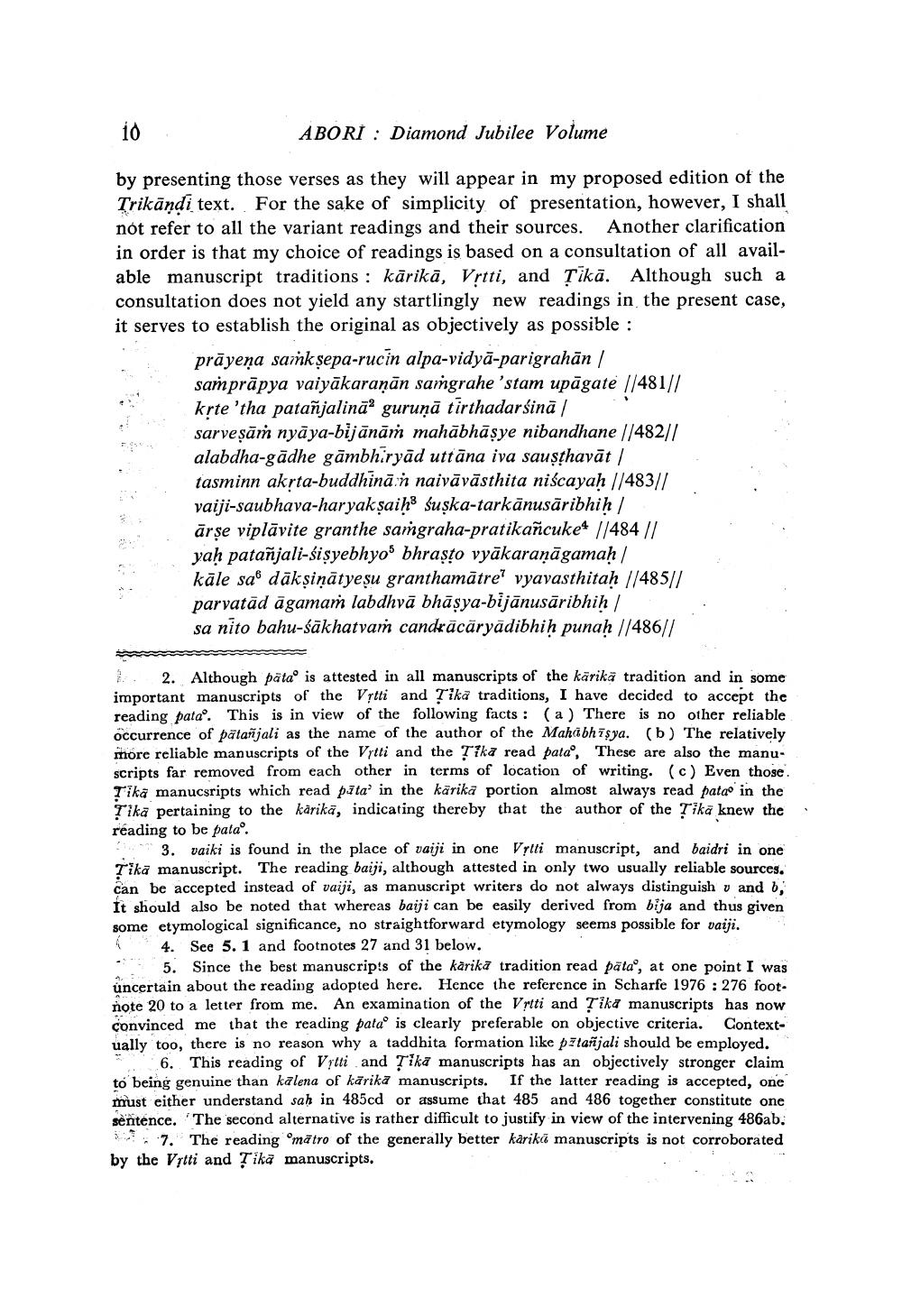Book Title: Concluding Verses Of Bhartrharis Vakya Kanda Author(s): Ashok Aklujkar Publisher: Ashok Aklujkar View full book textPage 2
________________ ABORI: Diamond Jubilee Volume by presenting those verses as they will appear in my proposed edition of the Trikandi text. For the sake of simplicity of presentation, however, I shall not refer to all the variant readings and their sources. Another clarification in order is that my choice of readings is based on a consultation of all available manuscript traditions: kārikā, Vṛtti, and Tikā. Although such a consultation does not yield any startlingly new readings in the present case, it serves to establish the original as objectively as possible : prayena samkṣepa-rucin alpa-vidya-parigrahān | samprāpya vaiyākaraṇān saṁgrahe 'stam upagate ||481// kṛte 'tha patanjalina guruṇā tirthadarsinā sarveṣām nyāya-bijānāṁ mahābhāṣye nibandhane ||482// alabdha-gādhe gambhiryād uttāna iva sauṣṭhavat | tasminn akṛta-buddhināṁn naivāvāsthita niscayaḥ ||483// vaiji-saubhava-haryakṣaiḥ śuṣka-tarkānusāribhiḥ/ ārṣe viplavite granthe samgraha-pratikañcuke1 //484 // yaḥ patanjali-siṣyebhyo bhraṣṭo vyākaraṇāgamaḥ| kāle sa dākṣinātyeṣu granthamātre" vyavasthitaḥ //485// parvatad āgamam labdhvā bhāṣya-bijānusāribhiḥ | sa nito bahu-śākhatvaṁ candrācāäryädibhiḥ punaḥ //486// 2. Although pata is attested in all manuscripts of the karika tradition and in some important manuscripts of the Vṛtti and Tika traditions, I have decided to accept the reading pata. This is in view of the following facts: (a) There is no other reliable occurrence of patanjali as the name of the author of the Mahabhiṣya. (b) The relatively more reliable manuscripts of the Vrtti and the Tika read pata, These are also the manuscripts far removed from each other in terms of location of writing. (c) Even those. Tika manucsripts which read pata' in the karika portion almost always read pata in the Tika pertaining to the karika, indicating thereby that the author of the Tika knew the reading to be pata. 3. vaiki is found in the place of vaiji in one Vṛtti manuscript, and baidri in one Tika manuscript. The reading baiji, although attested in only two usually reliable sources. can be accepted instead of vaiji, as manuscript writers do not always distinguish v and b, It should also be noted that whereas baiji can be easily derived from bija and thus given some etymological significance, no straightforward etymology seems possible for vaiji. See 5. 1 and footnotes 27 and 31 below. 4. 5. Since the best manuscripts of the karika tradition read pata, at one point I was uncertain about the reading adopted here. Hence the reference in Scharfe 1976: 276 footnote 20 to a letter from me. An examination of the Vrtti and Tika manuscripts has now convinced me that the reading pata is clearly preferable on objective criteria. Contextually too, there is no reason why a taddhita formation like pitanjali should be employed. 6. This reading of Vitti and Tika manuscripts has an objectively stronger claim to being genuine than kalena of karika manuscripts. If the latter reading is accepted, one must either understand saḥ in 485cd or assume that 485 and 486 together constitute one sentence. The second alternative is rather difficult to justify in view of the intervening 486ab. 7. The reading matro of the generally better karikā manuscripts is not corroborated by the Vrtti and Tika manuscripts.Page Navigation
1 2 3 4 5 6 7 8 9 10 11 12 13 14 15 16 17 18
